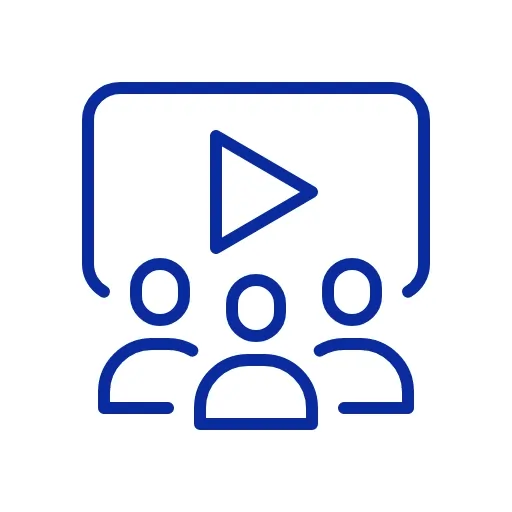Full Stack Development Course - DotNet in Pune
ECTI offers Full Stack Development - .NET Course in Pune! Unlock limitless career opportunities as a skilled Full Stack Developer with our Lifetime Job Assistance. Delve into .NET web development, frontend technologies, and database management. Our expert instructors and hands-on projects will empower you to create dynamic web applications. Join us now and pave your way to a successful and fulfilling career in the ever-expanding world of Full Stack Development!
4000+ students placed in renowned IT companies
See our placement recordspecially designed for graduates looking for a job in the IT industry. No prior coding experience required.

Hurry up! only 5 seats are available for this batch
6 months at 4 hours/day
Why Full Stack training?
A full-stack developer is someone who can take care of both the clients and server-side software. He/she can handle everything related to the development process from databases, system engineering to client and server.
Essentially, a full stack developer is someone who can take care of a project independently owing to his/her knowledge of all the stacks required in the development process.
Full-stack developers are familiar with each layer of the technology stack, so they can create an entire functional prototype of an application without any outside help. This makes them especially valuable for startups that need to release a minimum viable product (MVP) as soon as possible and polish it later. Full-stack developers can jump from one part of the product to another, allowing startups to keep their overhead minimal
Because full-stack developers can work on each layer of an application, they spend more time together, which helps create chemistry within the company. An experienced team of full-stack developers who know one another can be significantly more productive and agile than a much larger team of specialists who work in small, siloed units
The demand for full-stack developers is high because they are a valuable asset to any company. Their wide ranging knowledge allows them to be flexible, adaptable, and agile, which are essential skills for working on software products both in the startup world and elsewhere
Since 1999 we have helped over 4000 people launch their careers in the Tech and Digital industries and supported their further development with our blend of training and recruitment services.
The Department of Training & Placement is the backbone of any institute. From the very beginning the institute lays greater emphasis on industrial training, practical training for the students.
Arrangements for pre-placement talks, written tests, interviews and group discussions are made as per the requirement of the companies.
The institute is having very fruitful and meaningful relations with the various industries so that students are sure of their placements.
Full Stack Developer salary in India ranges between ₹ 2.2 Lakhs to ₹ 16.0 Lakhs with an average annual salary of ₹ 6.0 Lakhs. Salary estimates are based on 19.2k latest salaries received from Full Stack Developers.
In India, the average base salary of a full stack developer is ₹582,659/year.
This number could go as high as INR1400K to a low of 300K.
Average salary of full stack developer in india:
The rank of a full stack developer in India is surely among one of the highest-paid jobs positions. However, it is to be noted that the salary has many affecting factors ranging from experience, skills, location and employer
Different companies have different pay structures according to their ideologies.
A full-stack web developer is a person who is skilled in both frontend and backend development of a website. They are responsible for both the client side and server side of the website. They are professionals who are responsible for the websites easy accessibility, user-friendly experience, and troubleshooting. These full-stack web developers are responsible for the program database, servers, and browsers. They are one of the highly paid jobs in the development space.
Even though the web development industry is contributing more to the computer science world, people are not aware of these developers. These developers are relatively new compared to other professionals. This has a lot of potential in it. As the demand grows for this profession the pay range is also increasing simultaneously. From local startups to highly renowned companies like Meta, Microsoft, and Google hire a lot of full-stack web developers all around the world. The web developers salaries will be different from the startup space to top MNC companies.
The pay varies according to what the web developer brings to the organization. There are a lot of factors that influence the salary range of a web developer. First, let us see the salary in all rangesU.
Entry level salary: Rs. 3.5 LPA Average level salary: Rs. 5 LPA Experienced level salary: Rs. 7 LPALet us see what factors affect the salary range of a full-stack web developer. First of all, every hiring organization looks out for the experience of a candidate. More the experience, the salary they will get. Candidates with updated knowledge and more skills attached to their portfolio are expected to get more salaries. Candidates with more skills are considered to be preferred over any factors that influence the salary range. Candidates with skills like problem-solving, product knowledge, project management, and more will probably get more salary compared to a generic candidate who doesn't know anything other than development tools and technologies.
Regardless of the jobs, the professionals should hone their knowledge and skills around the industry they work in. That gives them leverage on salary expectations.
The career growth outlook for web developers, in general, is expected to grow at a rate of 13% through 2026 a significantly higher-than-average rate of growth. When looking at full-stack developers, more specifically, specialized areas of web development tend to be in even higher demand. Because of this, its expected that careers in full-stack development will continue trending this way.
Now more than ever, companies are looking for developers who meet their own expanding needs. Because web development influences practically every aspect of the business, savvy companies are looking for full-stack developers who can analyze their systems comprehensively, with a deep understanding of how each unit operates and how they fit in with the larger organization.
Today's rapidly changing technology means the demand for full-stack developers is much higher than the current supply. For those looking for a career in web development with above-average potential, starting on a path towards becoming a full-stack developer is a smart career move.
If you are a fresher in this field and are fighting in your mind about the fact that there are not many jobs for a full stack developer, then we have a fact check for you.
According to only monster.com there are approximately 20,000 Full-stack Developer's Jobs available in India. And this is just monster.com, wherein there are so many great other websites to explore including naukri.com, indeed, LinkedIn and so much more.
The massive demand and adaptable role of this position open many doors for the employer as well as the employee. This career option has the advantage of the following factors.
1. Multifaceted Market
Earlier small companies only were sticking to full stack developers. But, now the market for them has expanded. Big MultiNational Companies want to hire developers who work beyond one simple specialization for which full stack developer is the best.
2. Greater Responsibility
Greater productivity: Working on both sides of the ends, the client-side, as well as the server-side of the application, gives them an edge over other developers. Makes you a jack of all trades allowing you to understand many concepts at once which equates to better productivity.
3. Growth is perpetual
The irony of this ever-changing, ever-evolving role is growth is something constant here. As a full-stack developer is not a specialized developer, there will always be points and opportunities for learning. This will equip you for better productivity, versatility, and open to more job options.
The rising demand for full-stack developing experts is being headed by immense growth promises that the industry is offering. The feature of the sectors facing a notable demand increase from all projections of the industry gets linked to the startup culture expansion in all corners of the world.
Full stack development is a highly demanded field not only in India but also in the U.S which is reflected in the salary. The average salary for a full-stack developer salary in the US is $99,971 per year. An average full stack developer salary in India is 6.5 LPA, the salary in India ranges from 2.5 LPA to 17.0 LPA, the salaries could be decided on the experience, skillset, and upskilling level.
There is a constant question in the young minds are full stack developers in demand? Yes, definitely the full stack developers are in demand and the demand is growing rapidly. The reason is the growing number of online and digital platforms. The organizations understand the importance of having qualified professionals to boost the online presence and they provide competitive salary and scope of growth to acquire and retain the talent.
The future is full-stack. As per research, the demand for full-stack developers is going to rise by 20% in the coming years. In the words of Rishabh Kaul, Founder of Belong Full stack developers find more relevance in end-to-end product development startups or companies with smaller teams. Additionally, he also mentioned, Full stack developers in the product space are paid two times more in comparison to the ITES sector. Since they have knowledge and experience in front-end and back-end coding, their insights help large enterprise companies as well.
In order to understand how lucrative a career in full-stack development can be, presenting to you some of the facts regarding a career in full-stack development.
1. HIGH SALARY
As per indeed.com, in the US, the total income per income for a Full Stack developer ranges from $62.1K to $105K. As per glassdoor.com in India, the salary can range from Rs 351,000 1,000,000 for an experienced developer.
2. IMMENSE GROWTH
A recent report suggests that there are 1.4 million unfilled jobs for Full Stack developers in the USA. A full-stack developer is someone who has a broad vision and can be responsible for every aspect of the project. Their multi-skilled abilities make them highly in demand for jobs.
3. HIGHLY FLEXIBLE
By 2030, most of the IT jobs will be done from home. A full-stack developer has the expertise and knowledge of handling the entire project by themselves. This gives them high flexibility and opens up great avenues for them in the freelance sector.
4. QUALITY EMPLOYERS
Not only is the role of a full-stack developer well-paid, but it is also one of the most sought-after jobs by reputed organizations. Big organizations like Apple and General Assembly are always in the lookout for highly skilled full-stack developers.
Development: Full-stack .NET developers are involved in the entire development lifecycle of a web application, including requirements gathering, designing the architecture, coding, testing, and deployment. They write clean and efficient code using Java and related technologies.
Front-end Development: They work on the front-end portion of the application, which involves designing and implementing user interfaces using HTML, CSS, JavaScript, and front-end frameworks like Angular, React, or Vue.js. They ensure a responsive and visually appealing user experience.
Back-end Development: Full-stack .NET developers handle the back-end logic and server-side programming. They use Java frameworks like Spring Boot or Java EE to build APIs, handle data processing and storage, and integrate with databases and external services.
Database Management: They design and optimize databases, create database schemas, write SQL queries, and implement database access and manipulation using technologies like Hibernate or JDBC.
Troubleshooting and Debugging: Full-stack .NET developers diagnose and resolve issues in the application, perform debugging, and conduct thorough testing to ensure the software functions as expected.
Collaboration: They collaborate with cross-functional teams, including UI/UX designers, product managers, and QA engineers, to understand requirements, provide technical guidance, and deliver high-quality software solutions.
Continuous Learning: Full-stack .NET developers stay updated with the latest technologies, tools, and trends in the industry. They continuously enhance their skills and knowledge to adapt to evolving development practices and improve the efficiency and performance of their applications.
Project Management: Depending on their level of experience, full-stack .NET developers may also be responsible for project management tasks, such as estimating project timelines, breaking down tasks, coordinating with team members, and ensuring timely delivery of software.

Get Certified!




